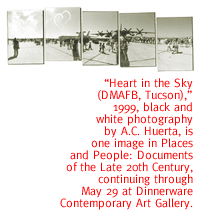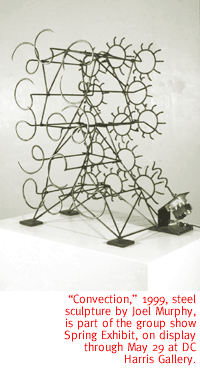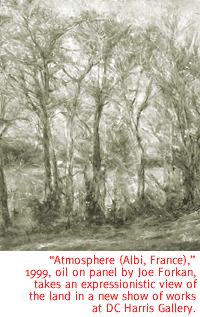

|

Photographer A.C. Huerta Takes On The American Way In His "Documents Of The Late 20th Century."
By Margaret Regan
AT THE END of the millennium, people tend to live at a
curious remove. Visitors to the Grand Canyon often spend more
time gazing at an IMAX movie about the canyon than they do actually
wandering the natural wonder outside the theatre door. People
drive nightmarish freeways around Los Angeles so they can pay
to meander down the carless and quaint and completely artificial
Main Street of Disneyland.
 A.C. Huerta photographs these phenomena of life in America, where
real experiences metamorphose into fake, and cultures blur together.
In his pictures, now at Dinnerware Gallery in a one-person show
called Place and People: Documents of the Late 20th Century,
war planes are distilled into tourist attractions and Santa visits
religious missions.
A.C. Huerta photographs these phenomena of life in America, where
real experiences metamorphose into fake, and cultures blur together.
In his pictures, now at Dinnerware Gallery in a one-person show
called Place and People: Documents of the Late 20th Century,
war planes are distilled into tourist attractions and Santa visits
religious missions.
 We can see the jolly man's back as he enters the dark cathedral
out of the white desert light in "Santa Visits San Xavier
del Bac." The cultures clash as much as the sun and shadow
do. Santa, icon of modern American secularism, strides easily
into a church that's part of a theological tradition extending
back two millennia. A couple of Tohono O'odham kids are looking
at Santa in puzzlement, but some tourists in shorts stride purposefully
along, apparently oblivious to the cultural syncretism playing
out right under their noses.
We can see the jolly man's back as he enters the dark cathedral
out of the white desert light in "Santa Visits San Xavier
del Bac." The cultures clash as much as the sun and shadow
do. Santa, icon of modern American secularism, strides easily
into a church that's part of a theological tradition extending
back two millennia. A couple of Tohono O'odham kids are looking
at Santa in puzzlement, but some tourists in shorts stride purposefully
along, apparently oblivious to the cultural syncretism playing
out right under their noses.
"Heart in the Sky" is even stranger. Shot at Davis
Monthan Air Force Base earlier this year, the picture showcases
a lineup of big fighter planes, the X's of their propellers jutting
aggressively into the sky. But these engines of death, now tethered
to the ground, have been rendered benign. Families and snowbirds
gather around the warplanes for entertainment, while high above
the crowds a pair of working skywriting planes trace out a big
loving heart in the wild blue yonder.
Huerta renders his ironic commentary on such garden-variety weirdness
in classic black-and-white gelatin silver prints, which are technically
sharper and more vivid than some of his previous work. The artist
arranges them in a disorderly fashion to reinforce a sense of
alienation. Each of the 14 works in the show is a panorama consisting
of five or six photos; together they add up to a single image,
but they're not smoothly connected. The pictures are staggered
on the wall--some high, some low--and separated by spaces. Together
they suggest a single image, but they don't add up--not precisely.
The artist has made them off-kilter to reinforce the sense of
dislocation.
 He's good at spotting the fakery of much of American life, especially
that of the tourist. "Strollers at Disneyland," 1997,
shows a pilgrimage to the Small World ride. The cavalcade of parked
strollers outside testifies to the fervor of the devotees inside,
who pay homage to Disney's commodification of the world's (infinitely
varied) cultures. Even real places, as opposed to the fake places
of the theme-park ilk, seem curiously unreal here. In "The
Cars of Taos Pueblo," the tourists' SUVs overwhelm the Indian
dwelling place. One of the most remarkable pieces of architecture
in the western world and one of the most continuously inhabited
sites in North America has become subsidiary to the car. The ancient
pueblo, a real place if ever there was one, is rendered just another
roadside attraction.
He's good at spotting the fakery of much of American life, especially
that of the tourist. "Strollers at Disneyland," 1997,
shows a pilgrimage to the Small World ride. The cavalcade of parked
strollers outside testifies to the fervor of the devotees inside,
who pay homage to Disney's commodification of the world's (infinitely
varied) cultures. Even real places, as opposed to the fake places
of the theme-park ilk, seem curiously unreal here. In "The
Cars of Taos Pueblo," the tourists' SUVs overwhelm the Indian
dwelling place. One of the most remarkable pieces of architecture
in the western world and one of the most continuously inhabited
sites in North America has become subsidiary to the car. The ancient
pueblo, a real place if ever there was one, is rendered just another
roadside attraction.
If Huerta probes the loss of place in American life, a painting
show at DC Harris Gallery around the corner from Dinnerware does
exactly the opposite. Spring Exhibit features a mix of
some 10 artists the gallery has shown since owner Daryl Childs
opened it in a Sixth Avenue storefront last fall. About half of
them are working within the landscape tradition.
 Joe Forkan, a fine painter who frequently does illustration work
for the Tucson Weekly, usually exhibits psychological works,
with figures placed in ambiguous interiors or landscapes. Here
he turns his attention entirely to the land, to salutary effect.
The lovely "Monsoon Light, New Mexico," a small oil
on panel, is a meticulously observed evocation of sky and land
in the Land of Enchantment. A vast western sky of golds, blues
and yellows presides above a rolling mountain range painted in
storm darks. A second New Mexico piece, "Fading Light (Animas,
N.M.)" similarly captures the contours of clouds and colors,
a fine blaze of yellow light flashing on the horizon. "Reflection
(Oregon Coast)" is a sumptuous rendition of waves crisscrossing
in a wild ocean.
Joe Forkan, a fine painter who frequently does illustration work
for the Tucson Weekly, usually exhibits psychological works,
with figures placed in ambiguous interiors or landscapes. Here
he turns his attention entirely to the land, to salutary effect.
The lovely "Monsoon Light, New Mexico," a small oil
on panel, is a meticulously observed evocation of sky and land
in the Land of Enchantment. A vast western sky of golds, blues
and yellows presides above a rolling mountain range painted in
storm darks. A second New Mexico piece, "Fading Light (Animas,
N.M.)" similarly captures the contours of clouds and colors,
a fine blaze of yellow light flashing on the horizon. "Reflection
(Oregon Coast)" is a sumptuous rendition of waves crisscrossing
in a wild ocean.
Forkan is hardly a strict realist, however; these oils are exuberantly
painted in a loose, expressionist style. They're as much about
color and brushstrokes as they are about the land. Similarly,
Farzad Nakhai, an architect-turned-painter, uses the desert hills
around Tucson as a jumping-off point for organic fields of purple,
green and gray. But both painters profit from the discipline of
gazing at the land around them; their works are an antidote to
the kind of alienation that Huerta chronicles. Their paintings
find the here in a nation slouching toward nowhere.
Places and People: Documents of the Late 20th Century,
photographs by A.C. Huerta, continues through Saturday, May 29,
at Dinnerware Contemporary Art Gallery, 135 E. Congress
St. Gallery hours are noon to 5 p.m. Tuesday and Wednesday, noon
to 7 p.m. Thursday, and noon to 9 p.m. Friday and Saturday. Huerta,
a Dinnerware member, gives a free gallery talk at
7 p.m. Thursday, May 20. For more information, call 792-4503.
Spring Exhibit, a group show of gallery artists,
continues through Saturday, May 29, at DC Harris Gallery,
41 S. Sixth Ave. Gallery hours are 1 to
5 p.m. Wednesday through Saturday, and by appointment. For more
information call 629-9446.

|
 |





